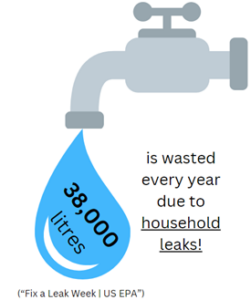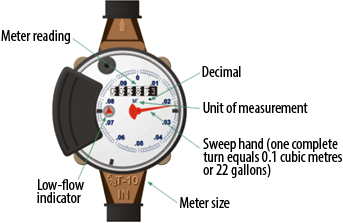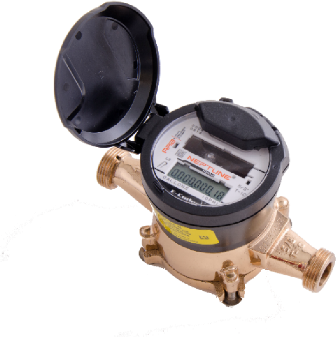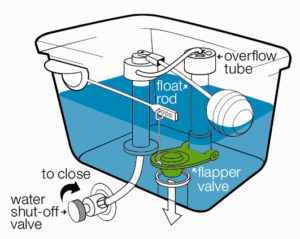On this page
Common household leaks
The most common household leaks are in toilets, faucets, shower heads, water softeners, sprinkler systems, and swimming pools.If you are unable to find the source of a water leak, please contact a professional plumber.
Why we need to check for leaks
Water leaks are massive water wasters which can lead to increased hydro bills, meaning your bill would increase even when you aren’t using any water.

Property owners are responsible for all plumbing maintenance and repairs. Many leaks cause serious damages to a house that can cost a fortune to fix.
Damages from leaks:
- Ruin electrical system
- Mold growth
- Corroded pipes
- Attract pests
- Saturate walls and lead to cracks in walls
How to find and fix a toilet leak
- Remove the lid from the toilet tank. Look and listen for leaks. The water should be about 0.6 centimetres (1/4 inch) below the top of the overflow tube. To adjust the water level, lower the float rod connected to the float ball.
- If you hear noise but the water isn’t moving, the leak is most likely occurring through the flapper located at the bottom of the tank.
- Check the chain to make sure it’s not caught on something.
Another way to detect a leak is by using food colouring or a free dye test kit from the City.
- Put a few drops of food colouring or a leak detector tablet/sticker in the toilet tank.
- Wait 20-30 minutes and don’t flush the toilet during this time.
- Check the water in the toilet bowl and if you see coloured dye in the water in the toilet bowl, there is a leak.
Your toilet may be leaking because of an outdated or broken flapper. Try cleaning the flapper and valve so they fit snugly.
If that doesn’t work, you may need to replace the flapper. Tip: Take a picture of your old flapper or bring it to the store so you buy the correct model!
If you still have a leak after checking these items, contact your plumber.
Detect leaks with your water meter
Turn off all faucets and water-using appliances.
Check your water meter—it’s usually in the basement where your water pipe enters the front of your home.
Record your meter’s reading at night when you are done using water for the day, and then again in the morning before using any water (if you have a water softener, do this test when it is not recharging). If the number increases overnight, you have a leak.
Reading an analog water meter

Reading a digital water meter


To find a leak, look for the leak symbol shaped like a tap

- If it is off, there are no leaks.
- If it is flashing, there has been water flowing for more than 12 hours over a 24 hour period.
- If it is on, water has been flowing for at least 24 hours, and you likely have a leak.
Do you have a leak?
If any of the following are true, you may have a water leak at home. A water audit can help you find the cause of a leak.
- I have a random increase in my water bill.
- My water bill shows that one person in my house uses more than $50 of water each month.
- I have noticed a constant puddle of water (near my toilet or faucet).
- I have a leaky fixture even after tightening.
- The leak symbol is lit on my digital water meter.
- The low-flow indicator is shaking/moving on my analog water meter.
- The water in my toilet bowl is coloured after performing a dye test.
- My outdoor irrigation system is not working, the heads are tilted or not fully popped up when turned on.
Book a free water audit
What is a home water audit?
- Review your water bill.
- Tests your toilets for leaks.
- Measure the flow rate of your faucets and shower heads.
- Assess your water-using appliances.
Benefits of a water audit
- Get a personalized report on your home’s water use.
- Access City rebates to save money and water.
- Free low flow aerator and showerheads.
- Receive helpful advice and tips on water conservation.
Learn more or book your water audit.
Contact us for more information
Water Services
519-837-5627
[email protected]

